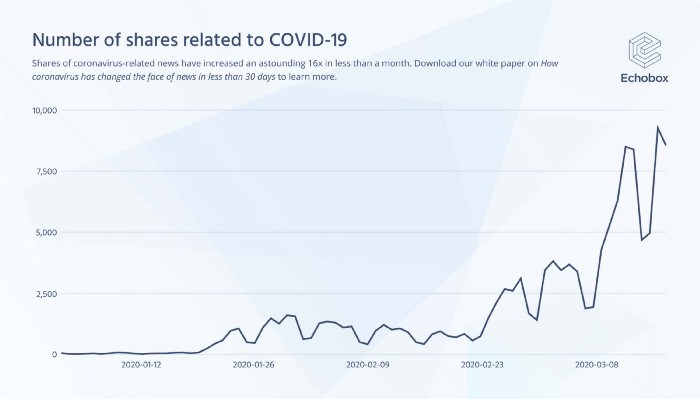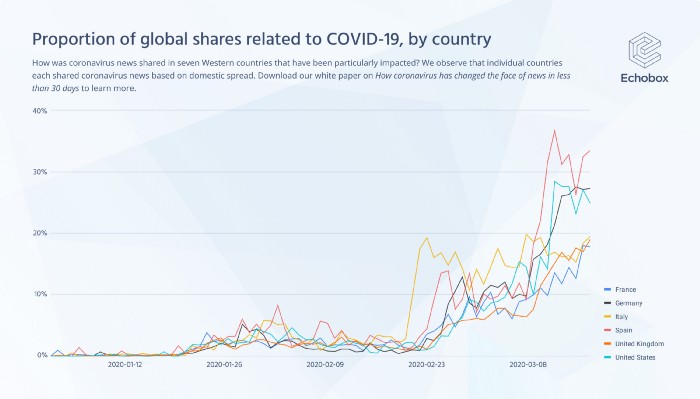For many people around the world, the increase in coronavirus news stories in recent weeks has been inescapable. But how has the news spread in some of the most-affected regions and what can we learn from how coverage about coronavirus/COVID-19 has unfolded?
To find out, we at Echobox studied more than 2.3 million stories shared to social media by 700 leading publishers in more than 50 countries between 1 January and 17 March 2020. We then looked at how many of those mentioned the words “corona” or “covid” in the share message. In this blogpost, we outline what we found.
Global shares related to coronavirus have increased exponentially…but only since community transmission took hold in Europe.
The below chart shows how shares about coronavirus have increased exponentially since mid-February — an astounding 16x increase in less than a month.

The meteoric rise began in earnest on 24 February, when six more countries announced their first case and financial markets plunged.
January — the calm before the storm
Looking back to January however, it is clear that despite the rapid spread of cases in China, there were a relatively low number of shares by news publications overall globally, compared to what was to follow.
Examining coronavirus content as a total percentage of all social media news shares (see below), we can see that it did not exceed 5% of all shares until 24 February. Prior to this, the highest proportion achieved was 4.5% on 30 January, when the World Health Organization declared coronavirus an international public health emergency. After that point, news shares on the subject stagnated for several weeks, as much of the world beyond China continued to go about its business.

Individual countries each shared coronavirus news based on domestic spread
Next, we looked at how coronavirus news was shared in seven Western countries that have been particularly impacted by the virus.

Italy saw shares on the topic increase from less than 3% of all stories to almost 20% of all shares in just 48 hours between 22 and 23 February. This coincided with the country becoming the first in Europe to introduce strict measures that placed almost 50,000 people in lockdown. Coronavirus shares have remained at a similar high level in Italy ever since.
As the above graph clearly shows, at this point in mid-February, the events taking place in Italy were yet to precipitate any significant increase in shares about coronavirus in the other countries we looked at.
The next peak came in Spain — two days later on 25 February. Coronavirus shares in Spain shot up from less than 4% to 14% in 48 hours, as the country detected ten new cases of coronavirus. Once again, this rapid increase was not replicated in any other country, continuing the theme of domestic dominance of a country’s news.
The next spike occurred in Germany, on 28 February, when domestic cases there increased by 104% in 24 hours to 53.
At this point, coronavirus news shares in all the countries we analysed were now above 5%. Italy, which continued to be the principal source of new coronavirus cases, still remained the country with the highest percentage of shares on COVID-19.
A March like no other
Little changed in coronavirus share levels for more than a week until 7 March, when we saw the first peak in the United States. News shares in the US jumped from less than 10% to more than 15% within 48 hours, as New York declared a state of emergency and confirmed cases rose from 332 to 444.
The following day, on 8 March, Italy recorded its second peak as the lockdown was extended to 16 million people in the north of the country.
Two days later, on 10 March, Spain recorded a massive increase in coronavirus shares, eclipsing the record levels set by Italy and recording 22% of all shares on that day. The day saw Spanish confirmed cases rise from 1,231 to 1,674 and the government shut schools and banned public events in several areas including Madrid.
More was to come. The 12 March was an unprecedented day for news, with Spanish coronavirus shares accounting for an incredible 37% of all shares that day. This was a day that saw members of the Spanish government and royal family being tested for coronavirus, schools closed nationwide and the IBEX dropping by a record 14%.
On this same day, 12 March, we see US stories record their second peak, at 28% — as President Trump took the unprecedented move of suspending travel from Europe to the US. Meanwhile, coronavirus shares in Germany broke the 20% level for the first time, as the country digested the impact of the US travel ban and began to debate the closure of schools.
Interestingly, while shares in France and UK grew gradually during this most recent period, and despite increasing government announcements and measures in those countries, levels did not exceed 20% or mirror the huge spikes seen in Spain, Germany and the US. It will be interesting to see whether that changes in the coming weeks if cases continue to rise in those countries.
Conclusion
It’s clear that as a topic, coronavirus has taken over the news sharing agenda in many countries around the world in dramatic fashion. This dominance has occurred incredibly quickly — in a way that most are unlikely to have seen before. In uncertain and unprecedented times like these, and when demand for the latest news has never been greater, publishers become vital sources of information and analysis — on a local, national and international level. It is therefore more important than ever before that the crucial role that journalism performs in times of crisis is fully recognised and understood.
How automation can play a role to help publishers manage their workflows in times of uncertainty
In the current climate, many companies and sectors face challenges. Social media publishing platforms such as Echobox are available to help publishers with some key day-to-day activities that may be impacted over the coming months and ensure that content distribution is not interrupted. These activities include the scheduling of social posts at optimal times during the working day, as well as on weekends and overnight. In addition, it is also possible to automatically select and post content to social media. For further information, please get in touch or download the white paper below:




